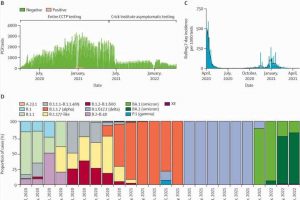Asymptomatic testing key to pandemic preparedness, new study finds


Asymptomatic PCR testing for NHS staff, provided by the Francis Crick Institute and University College London Hospitals (UCLH) NHS Foundation Trust and its diagnostic partner Health Services Laboratories, effectively detected COVID-19 infections that would have otherwise been missed.
In a new study of testing data from the Crick COVID Testing Pipeline, published June 19 as a Research letter in The Lancet, researchers examined test positivity rates across different NHS trusts.
The pipeline provided both asymptomatic screening and SARS-CoV-2 diagnostic testing for staff in eight NHS trusts and 98 local care homes and rehabilitation facilities, covering London boroughs with high rates of COVID-19 including Brent, Harrow, Barnet and Ealing.
Testing was then expanded to staff at the Crick to allow them to carry out essential research work, as well as supporting the Crick Vaccination Center, which delivered more than 80,000 vaccinations to the population of Camden. Data from the testing pipeline is being analyzed as part of the ongoing Legacy Study at the Crick and the National Institute for Health and Care Research (NIHR) UCLH Biomedical Research Center.
Researchers first observed that from the 680,000 tests run through the testing pipeline, 40.8% of all positive tests were from UCLH and The Royal Marsden NHS Foundation Trust, which both offered asymptomatic testing for staff and patients, to support delivery of COVID-19 secure cancer and surgical services. This high incidence suggests a significant number of additional infections were being detected by this strategy.
They then adjusted for organization size and calculated an incidence rate ratio for each site over the first four months of testing. This was the daily incidence of positive tests for each site, divided by the daily incidence estimates for London’s population. They found that the incidence of cases at the NHS sites that offered primarily asymptomatic testing were up to 13 times that of the London population at the time.
They also compared infection data from staff at the Crick and observed that peaks of infection were flatter than within the Institute’s local borough of Camden, suggesting that the strategy helped to keep overall numbers lower in the workplace. Asymptomatic testing also helped the Crick get back to 60%–75% research capacity within four weeks of each national lockdown across 2020–2021.
Chris Bailey, Clinical Fellow at the Crick and author of the study, said, “Our analysis suggests that asymptomatic testing was responsible for capturing a significant number of infections that would have otherwise been missed, and could have spread to more NHS staff and their patients. Strict testing strategies are especially important in protecting the most vulnerable patients.”
Emma Wall, UCLH Infectious Diseases consultant and Senior Clinical Research Fellow for the Legacy study, said, “The data we’ve gathered throughout the pandemic needs to be put to good use. We’ve shown that by repurposing lab facilities and partnering with local NHS trusts, the Crick was able to protect both staff and patients across London. This is a useful blueprint for future NHS-academic partnerships that could be rapidly set up in the event of another pandemic.”
The work highlights the strong partnership between UCLH and the Crick in research. Partnership working during COVID-19 between teams began early in the pandemic. At the start of the pandemic, a collaboration between the UCLH virology team and the Crick ensured that asymptomatic PCR testing was offered to health care workers—helping to create a safer environment for patients and staff across the sector.
More information:
Chris Bailey et al, Independent SARS-CoV-2 staff testing protected academic and health-care institutions in northwest London, The Lancet (2023). DOI: 10.1016/S0140-6736(23)00917-0
Journal information:
The Lancet
Source: Read Full Article